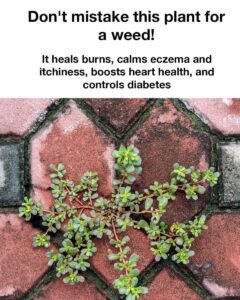
In the world of natural remedies, there exists a plant often mistaken for a mere weed, yet it possesses remarkable healing properties. This plant, known for its resilience and ubiquity, has been used for centuries in traditional medicine. It offers a range of health benefits, from soothing burns and calming eczema to boosting heart health and managing diabetes. In this article, we will explore the many virtues of this underestimated plant and how it can be a valuable addition to your natural health toolkit.
Identifying the Plant: Not Just a Weed
The plant in question is often found growing in the wild, in gardens, and sometimes even in the cracks of sidewalks. Its hardy nature allows it to thrive in various environments, leading many to dismiss it as a weed. However, upon closer inspection, one can identify its unique characteristics: its broad, green leaves, small flowers, and a distinctive aroma. Learning to recognize this plant is the first step in appreciating its medicinal potential.
Historical Uses and Cultural Significance
Throughout history, this plant has been revered in various cultures for its healing properties. In ancient times, it was used by indigenous peoples for treating wounds and skin conditions. Traditional Chinese medicine and Ayurveda have long incorporated it into their practices, recognizing its ability to balance bodily functions and promote overall health. Its cultural significance is a testament to its enduring value as a natural remedy.
Healing Burns: A Natural Remedy
One of the most well-known uses of this plant is its ability to heal burns. The plant’s leaves contain a gel-like substance that, when applied to the skin, provides a cooling and soothing effect. This gel helps to reduce inflammation, promote healing, and prevent infection, making it an excellent natural remedy for minor burns and sunburns.
Eczema Relief: Calming Skin Irritations
For those suffering from eczema, this plant offers a natural solution to calm skin irritations. The anti-inflammatory properties of the plant help to reduce redness and swelling, while its moisturizing effects soothe dry, itchy skin. Regular application of the plant’s extract can provide significant relief and improve the skin’s overall condition.
Soothing Itchiness: How It Works
Itchiness, whether from insect bites, allergies, or other causes, can be effectively alleviated with this plant. The compounds found in the plant have antihistamine properties, which help to reduce the sensation of itching. Applying the plant’s gel directly to the affected area can provide immediate relief and comfort.
Boosting Heart Health: The Plant’s Cardiovascular Benefits
Beyond its topical applications, this plant also offers benefits for heart health. It contains antioxidants and compounds that help to lower cholesterol levels and improve circulation. Regular consumption of the plant, whether in the form of tea or supplements, can contribute to a healthier cardiovascular system and reduce the risk of heart disease.
Managing Diabetes: Natural Blood Sugar Control
For individuals managing diabetes, this plant can be a valuable ally. It has been shown to help regulate blood sugar levels by enhancing insulin sensitivity and reducing glucose absorption in the intestines. Incorporating the plant into a balanced diet can aid in maintaining stable blood sugar levels and support overall diabetes management.
Scientific Studies and Evidence
Numerous scientific studies have been conducted to validate the health benefits of this plant. Research has demonstrated its effectiveness in treating burns, reducing inflammation, and managing blood sugar levels. These studies provide a solid foundation of evidence supporting the plant’s use as a natural remedy and highlight its potential in modern medicine.
How to Grow and Harvest the Plant
Growing this plant is relatively easy, as it thrives in a variety of conditions. It prefers well-drained soil and plenty of sunlight but can also tolerate partial shade. To harvest, simply cut the mature leaves close to the base of the plant. This ensures a continuous supply of fresh leaves for medicinal use.
Preparation and Application Methods
There are several ways to prepare and apply this plant for its health benefits. For topical use, the gel can be extracted from the leaves and applied directly to the skin. For internal use, the leaves can be brewed into a tea or processed into supplements. Each method offers unique benefits, allowing for versatile use of the plant.
Potential Side Effects and Precautions
While generally safe, this plant can cause allergic reactions in some individuals, particularly those with sensitive skin. It is important to conduct a patch test before applying it extensively. Additionally, excessive consumption of the plant’s extracts can lead to digestive issues. As with any natural remedy, it is advisable to consult with a healthcare professional before use, especially for those with pre-existing conditions.
Conclusion: Embracing Nature’s Medicine
In conclusion, this remarkable plant, often overlooked as a weed, holds a wealth of healing potential. Its ability to treat burns, soothe skin conditions, support heart health, and manage diabetes makes it a valuable addition to natural medicine. By embracing this plant, we can tap into nature’s pharmacy and enhance our well-being with its myriad benefits.



